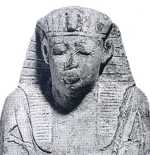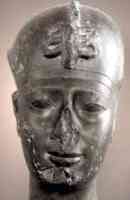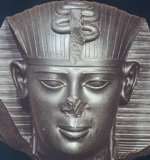| 26th Dynasty (138) 663-525BC | |
| First three (four) rulers of this dynasty are separated by K. Kitchen as protosaite Dynasty XXV. The real capital was at Memphis, but we speak of a Saite Period to characterize the regime and the culture of the era ruled by kings of XXVI Dynasty. It was a period of peace and economic prosperity, and of artistic accomplishments in which innovation was slipped into an archaizing mold. This Saite renaissance saw Egypt take its place in a new international alliance, which included not only recruitment of Greek and Carian hoplites, Jewish auxiliaries, and Phoenician ship-owners but also maritime activity and exchanges with Greek cities. Confrontation with the Kushites and the Babylonians led to a lengthy combat in which the kings were unable to establish a lasting dominion in Asia. Thanks to their incommensurably superior military force, the Persians would defeat this house of Sais, but the first of these pharaohs from Iran, who were proclaimed sons of Neith, would maintain religious forms and resources inherited from the Saites. | |
|
Psamtit I |
|
 Son
of Nekau I the prince of Sais. He ruled in Athribis under
Assyrian name Nebushezibanni. After retreat of Assyrians he
overtook rule and with support from Ionian and Karyan
mercenaries gained principality over princes of Delta. He
reached with them as far as to Palestine and laid siege to
Ashdod. He managed to annex Central Egypt which was administered
by regents of Heracleopolis
- Padiiset and Sematauiefankh. In 656 he overtook a rule
also at Thebes and thank to diplomatic efforts gained for his
daughter Nitocris
a title of
divine
adoratrice
of Amun which de facto gave him rule over Upper Egypt. Recently
it has been assumed that Nitocris
became the
divine
adorer
of Amun greatly thanks to Sematauiefankh, the prince of Heracleopolis
who gave military support to Psametik.
Military activity of Psametik
in later years focused mainly in Libya and Asia. In response to
increasing power of Media and Babylon Psametik supported Assyria
which was close to its downfall in battles in 616 and 610 BC.
Building activity of this ruler is known from extending Serapeum
in year 52 of his rule and numerous monuments mainly in the
Delta. He died after long reign and was buried at Sais. Son
of Nekau I the prince of Sais. He ruled in Athribis under
Assyrian name Nebushezibanni. After retreat of Assyrians he
overtook rule and with support from Ionian and Karyan
mercenaries gained principality over princes of Delta. He
reached with them as far as to Palestine and laid siege to
Ashdod. He managed to annex Central Egypt which was administered
by regents of Heracleopolis
- Padiiset and Sematauiefankh. In 656 he overtook a rule
also at Thebes and thank to diplomatic efforts gained for his
daughter Nitocris
a title of
divine
adoratrice
of Amun which de facto gave him rule over Upper Egypt. Recently
it has been assumed that Nitocris
became the
divine
adorer
of Amun greatly thanks to Sematauiefankh, the prince of Heracleopolis
who gave military support to Psametik.
Military activity of Psametik
in later years focused mainly in Libya and Asia. In response to
increasing power of Media and Babylon Psametik supported Assyria
which was close to its downfall in battles in 616 and 610 BC.
Building activity of this ruler is known from extending Serapeum
in year 52 of his rule and numerous monuments mainly in the
Delta. He died after long reign and was buried at Sais.
|
|
|
Neco II |
|
 Son
of Psametik I and queen Mehitenusekhet. He supported Assyrians
against Babylonia. In consequence of Syrian expedition commanded
personally by Nekau in 609 BC king of Juda, Josiash had been
defeated under Meggido. In his place Nekau put his son Joakhaz
and subsequently – Joiakim, thus restoring Egyptian supremacy
over Palestine. After being defeated by Babylonian army in
renowned battle at Karkemish in 605 BC, army of Nekau II
retreated to Egypt and it was only sudden death of Nabopolassar,
the father of Nabukhodonosor, which saved Egypt from attack. In
601 BC Nekau repelled Babylanian attack and according to
Herodotus, captured Gaza while pursuing the enemy. He created
Egyptian fleet, built in his order by Corinthian craftsmen. He
started building a canal to connect eastern arm of Nile (north
of Bubastis) with Red Sea. The works had been completed under
Darius the Great. It is believed that he organized trade
expedition which for the firs time in history circumnavigated
Africa. This event has been questioned as historical fact and
scarabs of Brussels documenting it have been probably modern
forgery. Nakau II died in May 594 BC leaving the throne to his
son, Psametik II. Son
of Psametik I and queen Mehitenusekhet. He supported Assyrians
against Babylonia. In consequence of Syrian expedition commanded
personally by Nekau in 609 BC king of Juda, Josiash had been
defeated under Meggido. In his place Nekau put his son Joakhaz
and subsequently – Joiakim, thus restoring Egyptian supremacy
over Palestine. After being defeated by Babylonian army in
renowned battle at Karkemish in 605 BC, army of Nekau II
retreated to Egypt and it was only sudden death of Nabopolassar,
the father of Nabukhodonosor, which saved Egypt from attack. In
601 BC Nekau repelled Babylanian attack and according to
Herodotus, captured Gaza while pursuing the enemy. He created
Egyptian fleet, built in his order by Corinthian craftsmen. He
started building a canal to connect eastern arm of Nile (north
of Bubastis) with Red Sea. The works had been completed under
Darius the Great. It is believed that he organized trade
expedition which for the firs time in history circumnavigated
Africa. This event has been questioned as historical fact and
scarabs of Brussels documenting it have been probably modern
forgery. Nakau II died in May 594 BC leaving the throne to his
son, Psametik II.
|
|
|
Psamtit II |
|
| Son of Nekau II and queen Khedebnetiretbinet. During short time of his reign he had lead expedition against Nubians as documented in stele inscriptions and by Herodotus. Results of this expedition are not clear to us. It is known that in one of the battles great number of Nubians was brought to death and 4200 of others were captured. It is not known whether the capital at Napata was conquered. Of Psametik period of rule survived numerous artifacts, he was decorating buildings with tiny architectonic accents, lot of edifices he erected himself, lot of them just usurped. He died in his way back from Phoenicia. | |
|
Apries |
|
 Son
of Psametik II. Energetic and brave ruler. He warred with
Phoenites, captured Sydon and for 13 years laid siege to Thyr. He
supported Jewish uprising against Babylon which ended up with a
conflict with Nabuchodonozor. In 586 BC Jerusalem had been captured
by Babylonians. Under Apries the Jewish community on Elephantine
arose. Due to revolt in his army in 569 BC he lost his function,
captured by Amasis, next handed over to populace and strangled.
Another version tells that Aproes was brought to death in march 22,
569 BC during the battle of Amasis army with Nabuchodonozor, where
he supported probably Babylonians. According to Herodotus, Apries
was buried by Amasis in the temple-tombs at Sais. Son
of Psametik II. Energetic and brave ruler. He warred with
Phoenites, captured Sydon and for 13 years laid siege to Thyr. He
supported Jewish uprising against Babylon which ended up with a
conflict with Nabuchodonozor. In 586 BC Jerusalem had been captured
by Babylonians. Under Apries the Jewish community on Elephantine
arose. Due to revolt in his army in 569 BC he lost his function,
captured by Amasis, next handed over to populace and strangled.
Another version tells that Aproes was brought to death in march 22,
569 BC during the battle of Amasis army with Nabuchodonozor, where
he supported probably Babylonians. According to Herodotus, Apries
was buried by Amasis in the temple-tombs at Sais. |
|
|
Amasis |
|
 Possibly
related to Apries, father of Psametik III, husband of Tanetkheta.
As a minister of Apries he usurped the rule. He repulsed
Babylonian attack and captured part of Cyprus. Made alliance
with Kresus, the king of Lydia, and with Policrates
of Samos. He married Ladice, a Greek from
Cyrene. He favored Greeks, granted city of Naucratis
to Greek merchants as well as privileges which allowed immense
growth of economy of this polis. He also allowed other Greek
settlements and worshipping places in the s Delta to be founded.
One of the documents gives evidence that in year 41 of Amazis’
rule an expedition to Nubia took place. He extended Temple of
Neith at Sais, erected Sanctuary of Isis (Herodotus) at Memphis,
built temples at Abydos and Mendes, nilometer in the Temple of
Sep and many other structures in Baharija oasis and at
Heliopolis. He was buried in temple complex at Sais.
Amasis has been regarded as one of the six greatest Egyptians
legislators and honored by Greeks with the title of one of
the Seven Sages. Possibly
related to Apries, father of Psametik III, husband of Tanetkheta.
As a minister of Apries he usurped the rule. He repulsed
Babylonian attack and captured part of Cyprus. Made alliance
with Kresus, the king of Lydia, and with Policrates
of Samos. He married Ladice, a Greek from
Cyrene. He favored Greeks, granted city of Naucratis
to Greek merchants as well as privileges which allowed immense
growth of economy of this polis. He also allowed other Greek
settlements and worshipping places in the s Delta to be founded.
One of the documents gives evidence that in year 41 of Amazis’
rule an expedition to Nubia took place. He extended Temple of
Neith at Sais, erected Sanctuary of Isis (Herodotus) at Memphis,
built temples at Abydos and Mendes, nilometer in the Temple of
Sep and many other structures in Baharija oasis and at
Heliopolis. He was buried in temple complex at Sais.
Amasis has been regarded as one of the six greatest Egyptians
legislators and honored by Greeks with the title of one of
the Seven Sages.
|
|
|
Psamtit III |
|
|
Son
of Amasis. Ruled merely several months. Betrayed by one of his
allies, Phanes of Halicarnas, he was defeated at Pelusium by
Persians and forced to retreat to Memphis. The city capitulated
after long siege. Now and again Psametik was
trying to incite rebellions, but was finally executed by Cambyzes. |
|